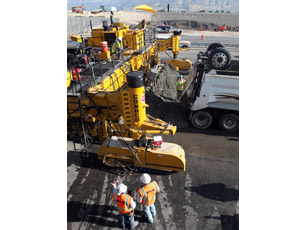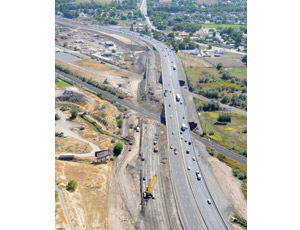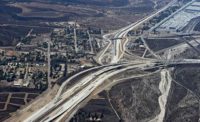When the Utah Dept. of Transportation sent out an RFP for the $1.1-billion reconstruction of a portion of Interstate 15 south of Salt Lake City, it expected proposals that would include a fair amount of traffic-altering road closures.


But Provo River Constructors, one of three design-build teams to respond, offered something completely different.
The RFP assumed that the number of lanes in each direction would be reduced by at least one lane during the multiyear roadway and overpass reconstruction effort.
Provo River Constructors— a design-build team that includes: Fluor of Irving, Texas; Ames Construction Co. Inc. of Burnsville, Minn.; Ralph L. Wadsworth Construction Co. and Wadsworth Bros. Construction, both of Draper, Utah—not only proposed keeping all existing lanes open during construction of the 24-mile project, but said it would finish work in three years—11 months faster than the next closest bidder.
The I-15 Corridor Expansion (CORE) project covers a major north-south trucking route through Utah and is the area’s main thoroughfare, with an average of 130,000 cars driving the roadway each day.
“One of the critical aspects going into this was the maintenance of traffic,” says Todd Jensen, I-15 CORE’s deputy director with UDOT. “This team had the best concept.”
The I-15 CORE project broke ground in January 2010 and substantial completion is expected by December 2012. The project restores and expands 24 miles of I-15 from Lehi to Spanish Fork, starting approximately 20 miles south of Salt Lake City. The job adds two additional lanes in each direction; adds, rebuilds or reconfigures 63 bridges; and reconstructs or widens 10 interchanges.
The upgrades are expected to meet or exceed travel demands through the year 2030, when car trips are projected to be 240,000 every day.
Temporary Investment Provo River Constructors is avoiding significant traffic impacts by adding temporary roadway in some areas and reconfiguring lanes in others. Approximately half of the project includes the construction of temporary asphalt lanes on either the east or west side of the freeway, allowing crews to divert traffic while construction continues nearby. Once roadwork in an area is complete, the temporary roadway is readjusted to the new elevations, paved with concrete and incorporated into the permanent design.
In portions of the project where space does not allow for temporary new construction, HOV lanes are converted to general-purpose lanes, shoulder widths are reduced and existing lanes reconfigured to avoid lane reduction and keep traffic moving. Maintaining flow and keeping lanes open during a project has required a good deal of forethought on the part of the contractors.
“We have a core group of 24 guys who spend 70% of their day planning activities and disseminating that information to the craftworkers,” says Wayne Bowden, CORE’s Area II construction manager and senior project manager with Ralph L. Wadsworth Construction Co.
Further complicating the job is its breakneck two-year schedule, but the effort remains on track, thanks to careful preplanning and the experience of the project team. “The fact that they can rebuild this much and keep existing lanes of traffic open is pretty amazing,” Jensen says.
“We dedicate a lot of time during the proposal process for scheduling so we can refine our scope, take on some risk and do a few things from a geotechnical standpoint that will help us with the schedule,” says Tim Odell, a senior project manager with Ames Construction Co. Inc. and the construction deputy director with Provo River Constructors.“So far, the weather has been cooperative, and we’ve been able to react to some unforeseen conditions.”
Applying ABC In addition to roadway widening, the CORE project includes rebuilding or adding 63 bridges across I-15, four of which are being built using the accelerated bridge construction method. Here, the bridge superstructure is built away from the freeway in a UDOT right-of-way, then quickly placed over the interstate during a weekend or nighttime closure.
The ABC method is used in areas where in-place construction would most impact traffic on I-15, Bowden says. It also allows the substructure on the roadway and the superstructure nearby to be built simultaneously, saving considerable time.
Safety is also an issue, Jensen adds. When crews are working in the right-of-way, they aren’t working over live traffic, and the potential for dropped tools or other accidents is greatly minimized.
New technology is playing a significant role in the I-15 CORE project. Crews are laying all six courses of material using a global positioning system that eliminates the need for wire lines. While traditional surveying uses driven wood hubs and wire to measure grade and guide machinery, the GPS uses satellites to precisely identify elevations of earthwork, asphalt and concrete.
Sensors mounted on the retrofitted Gomaco paver and along the sides of the roadway help the paver determine the proper alignment of the concrete lanes and their required thickness.
“This results in a more efficient roadway profile of each layer,” Bowen says. “We evaluate all the data and plug it into the paving model. It helps all layers hold a tighter tolerance for paving.”
In the Beginning When project planners created an environmental impact statement for the expansion of I-15 in 2004, it indicated the need for 43 miles of roadway, stretching from Salt Lake County to the southern end of Utah County and totaling nearly $6 billion.
Different funding options were presented to the legislature, which eventually funded a 14-mile stretch from American Fork Main Street to Provo Center Street. UDOT then reached out to bidders, asking for proposals that would address the specific segment while offering additional value within the fixed budget.
The approach turned the traditional procurement method on its head.
“Normally, we come to contractors with a defined scope,” Jensen says. “This time we came to them and said, ‘We have 43 miles of needs but only this much money.’”
Provo River Constructors’ bid offered to construct 24 miles of roadway, considerably more miles than the state requested, along with the alluring traffic maintenance and schedule benefits.
“We really feel like we stretched the available dollars to get the best possible project for the public for the best value,” Jensen says.
One year into the CORE project, the construction team’s preplanning and scheduling efforts seem to be paying off. The project is “close to the baseline schedule,” with some sections coming in ahead of schedule, Bowen says.
“We are where we anticipated being by the end of 2010,” Odell adds.
Backups are minimal, even during busy game days at nearby Brigham Young University, where football games can draw more than 60,000 fans.
“That’s a huge crush of people,” says Rob Clayton, UDOT’s maintenance-of-traffic oversight engineer for the CORE project. “The (construction team) minimizes closures during those time frames, and they’ve also helped us gather and disseminate quality information to other stakeholders.”




Post a comment to this article
Report Abusive Comment